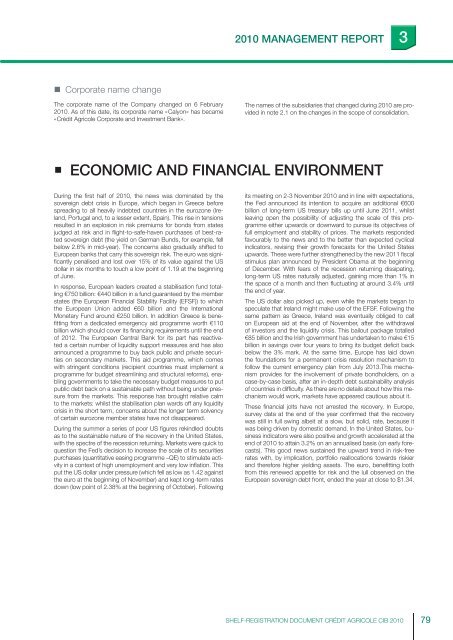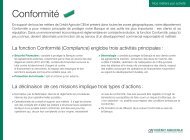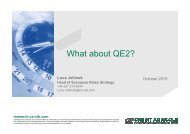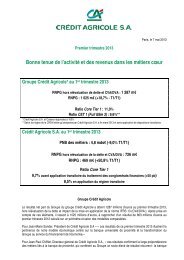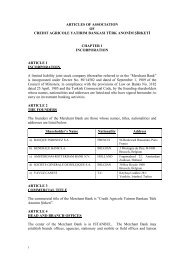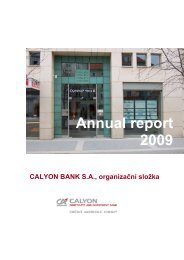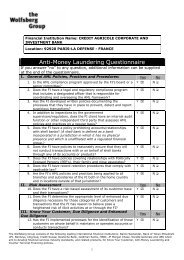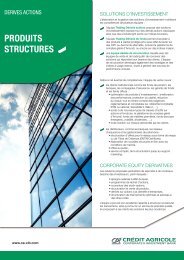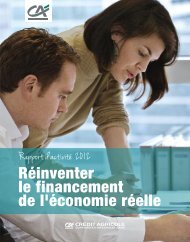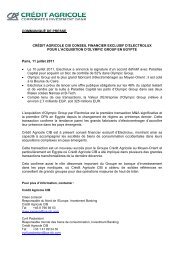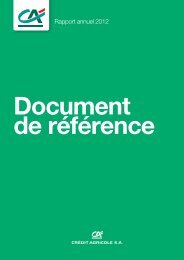ourexpertise - Crédit Agricole CIB
ourexpertise - Crédit Agricole CIB
ourexpertise - Crédit Agricole CIB
Create successful ePaper yourself
Turn your PDF publications into a flip-book with our unique Google optimized e-Paper software.
2010 MANAGEMENT REPORT 3• Corporate name changeThe corporate name of the Company changed on 6 February2010. As of this date, its corporate name « Calyon« has became« <strong>Crédit</strong> <strong>Agricole</strong> Corporate and Investment Bank«.The names of the subsidiaries that changed during 2010 are providedin note 2.1 on the changes in the scope of consolidation.• ECONOMIC AND FINANCIAL ENVIRONMENTDuring the fi rst half of 2010, the news was dominated by thesovereign debt crisis in Europe, which began in Greece beforespreading to all heavily indebted countries in the eurozone (Ireland,Portugal and, to a lesser extent, Spain). This rise in tensionsresulted in an explosion in risk premiums for bonds from statesjudged at risk and in fl ight-to-safe-haven purchases of best-ratedsovereign debt (the yield on German Bunds, for example, fellbelow 2.6% in mid-year). The concerns also gradually shifted toEuropean banks that carry this sovereign risk. The euro was significantly penalised and lost over 15% of its value against the USdollar in six months to touch a low point of 1.19 at the beginningof June.In response, European leaders created a stabilisation fund totalling€750 billion: €440 billion in a fund guaranteed by the memberstates (the European Financial Stability Facility (EFSF)) to whichthe European Union added €60 billion and the InternationalMonetary Fund around €250 billion. In addition Greece is benefitting from a dedicated emergency aid programme worth €110billion which should cover its fi nancing requirements until the endof 2012. The European Central Bank for its part has reactivateda certain number of liquidity support measures and has alsoannounced a programme to buy back public and private securitieson secondary markets. This aid programme, which comeswith stringent conditions (recipient countries must implement aprogramme for budget streamlining and structural reforms), enablinggovernments to take the necessary budget measures to putpublic debt back on a sustainable path without being under pressurefrom the markets. This response has brought relative calmto the markets: whilst the stabilisation plan wards off any liquiditycrisis in the short term, concerns about the longer term solvencyof certain eurozone member states have not disappeared.During the summer a series of poor US fi gures rekindled doubtsas to the sustainable nature of the recovery in the United States,with the spectre of the recession returning. Markets were quick toquestion the Fed’s decision to increase the scale of its securitiespurchases (quantitative easing programme –QE) to stimulate activityin a context of high unemployment and very low infl ation. Thisput the US dollar under pressure (which fell as low as 1.42 againstthe euro at the beginning of November) and kept long-term ratesdown (low point of 2.38% at the beginning of October). Followingits meeting on 2-3 November 2010 and in line with expectations,the Fed announced its intention to acquire an additional €600billion of long-term US treasury bills up until June 2011, whilstleaving open the possibility of adjusting the scale of this programmeeither upwards or downward to pursue its objectives offull employment and stability of prices. The markets respondedfavourably to the news and to the better than expected cyclicalindicators, revising their growth forecasts for the United Statesupwards. These were further strengthened by the new 2011 fi scalstimulus plan announced by President Obama at the beginningof December. With fears of the recession returning dissipating,long-term US rates naturally adjusted, gaining more than 1% inthe space of a month and then fl uctuating at around 3.4% untilthe end of year.The US dollar also picked up, even while the markets began tospeculate that Ireland might make use of the EFSF. Following thesame pattern as Greece, Ireland was eventually obliged to callon European aid at the end of November, after the withdrawalof investors and the liquidity crisis. This bailout package totalled€85 billion and the Irish government has undertaken to make €15billion in savings over four years to bring its budget defi cit backbelow the 3% mark. At the same time, Europe has laid downthe foundations for a permanent crisis resolution mechanism tofollow the current emergency plan from July 2013.This mechanismprovides for the involvement of private bondholders, on acase-by-case basis, after an in-depth debt sustainability analysisof countries in diffi culty. As there are no details about how this mechanismwould work, markets have appeared cautious about it.These fi nancial jolts have not arrested the recovery. In Europe,survey data at the end of the year confi rmed that the recoverywas still in full swing albeit at a slow, but solid, rate, because itwas being driven by domestic demand. In the United States, businessindicators were also positive and growth accelerated at theend of 2010 to attain 3.2% on an annualised basis (on early forecasts).This good news sustained the upward trend in risk-freerates with, by implication, portfolio reallocations towards riskierand therefore higher yielding assets. The euro, benefi tting bothfrom this renewed appetite for risk and the lull observed on theEuropean sovereign debt front, ended the year at close to $1.34.SHELF-REGISTRATION DOCUMENT CRÉDIT AGRICOLE <strong>CIB</strong> 2010 79


